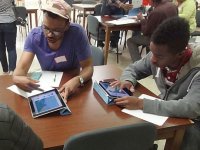A Working Model for Blended Learning in an Urban School
Editor's Note: Dr. Lourenco Garcia, Adjunct Professor at Northeastern University and Principal of Revere High School, co-authored this post.
In just two years, Revere High School (RHS) went from a low-performing school as classified by the Massachusetts Department of Education to winning the 2014 High School Gold Award at the National Center for Urban School Transformation (NCUST) conference in San Diego. This past April, the school also ranked Silver on a U.S. News and World Report survey of the best U.S. high schools. With a population of approximately 1,500 students, 60 percent of whom are of color and 71 percent of whom are low-income, RHS is a national example of the type of programmatic systems change needed to move our schools forward.
RHS students outscored the state average on the Massachusetts Comprehensive Assessment System (MCAS) test this year. Its dropout rate fell to 2.1 percent while its attendance rate climbed to 95 percent -- averages higher than the district and even the entire state. Surveys administered to RHS students and their parents have consistently indicated an overall satisfaction with the teaching and learning that goes on inside its walls. While we know that satisfaction surveys are not as important as student learning gains, these are still welcome and leading indicators of improvement.
But how does a school that was among the lowest performing in the state experience such a dramatic turnaround in such a short time?
There are plenty of evidence-based recommendations for how to quickly optimize student achievement in low-performing schools, but an entry point for a broader, deeper systems change at RHS was to redesign its educational system and adopt blended learning.
1. Shifting the Teaching and Learning
Adopting a blended learning environment requires taking a holistic look at the entire school community -- students, teachers, staff, and parents -- and making changes that allow each of these groups to buy into the shift.
The first thing RHS did was to adopt flipped learning as a teaching model. In a flipped learning classroom, students might be assigned to create a multimedia presentation of their interpretation of Shakespeare's Hamlet. This is just an example of how learners develop ownership of learning. The lesson for students is determining how to present and deliver information to a group and initiate substantive dialogue -- the presentation itself is the test. One hundred percent of RHS' teachers are certified in flipped learning.
All administrators and teachers use iWalkthrough to collect data and observe and improve their skills. This Web-based device helps teachers capture and share classroom activities online, and receive instantaneous feedback on their implementation of a lesson. Teachers also use it to observe each other's classes, as well as identifying potential areas for further professional development and finding support through professional learning groups (PLGs), which were established to help teachers help each other.
2. Shifting the Culture
Each teacher needed to know how to use an iPad and a SMARTBoard as platforms for daily instruction. Some PLGs went out of state to expand their understanding of flipped learning and how to change instruction from teacher-directed to student-centered.
Then RHS implemented a 1:1 iPad program that plugged all students and faculty into the new learning system, allowing the school to surge forward into becoming a model of 21st century education. The iPad program gives teachers 24-hour access to Schoology, an online hub for posting lectures, uploading videos, and sharing assignments. Students can also access Schoology -- any time and from anywhere. Additionally, the school uses PowerSchool, an online platform for storing and accessing information such as attendance records, grades, and evaluations. All of this has helped to endorse the philosophical premise that learning can take place anywhere and at any time.
3. Embracing the Change
The library culture was also altered for successful implementation of blended learning. Unlike old school libraries, where talking or interacting might cost a student his or her class credit, it's impossible not to communicate in the Learning Commons (formerly known as the RHS library). Equipped with broadband wireless capabilities and Internet access, this flexible space is where students and teachers convene to plan lessons, deliver instruction, and complete assignments. As a physical space, the Commons enforces, in a tangible way, the flexible nature of learning. There are often multiple workshops taking place concurrently here. For instance, in one corner, a college representative might be meeting with a group of students; in another corner, parents may be interacting with teachers; students might be completing their language assignment in a third corner; or they may be filming a video for a class assignment in a fourth corner.
The Learning Commons also has a Genius Bar where students work one-hour shifts and receive internship credit for providing technical assistance to people seeking help with their iPads.
Blended learning has changed the school and the community of Revere. Whether in classrooms or in the Learning Commons, at home or in restaurants, or while traveling by train or by airplane, students know they can learn anywhere and at any time. Families in the community see the school providing equal access and opportunity for their children. Having shifted three key dimensions of any school -- the teaching and learning, the system structures, and the culture -- RHS is now an emerging exemplar not only of blended learning, but also the steps we must take to grow this strong model across the Commonwealth of Massachusetts and even the nation.
Has your school undergone similar transformations? Please tell us about it in the comments.
